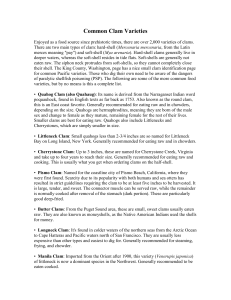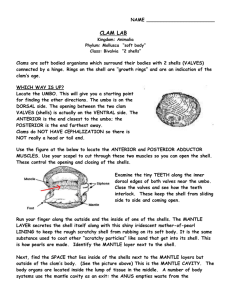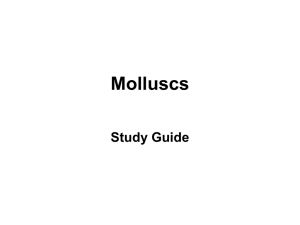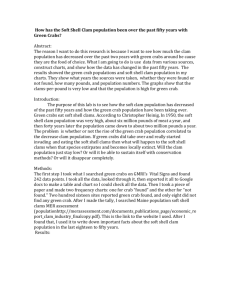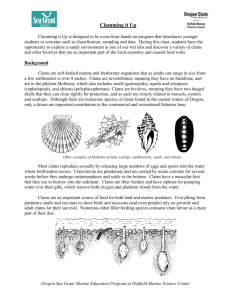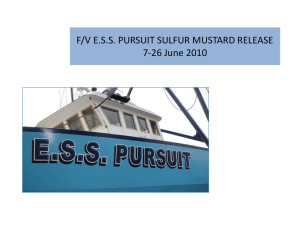Clam Dissection - Biology Junction
advertisement
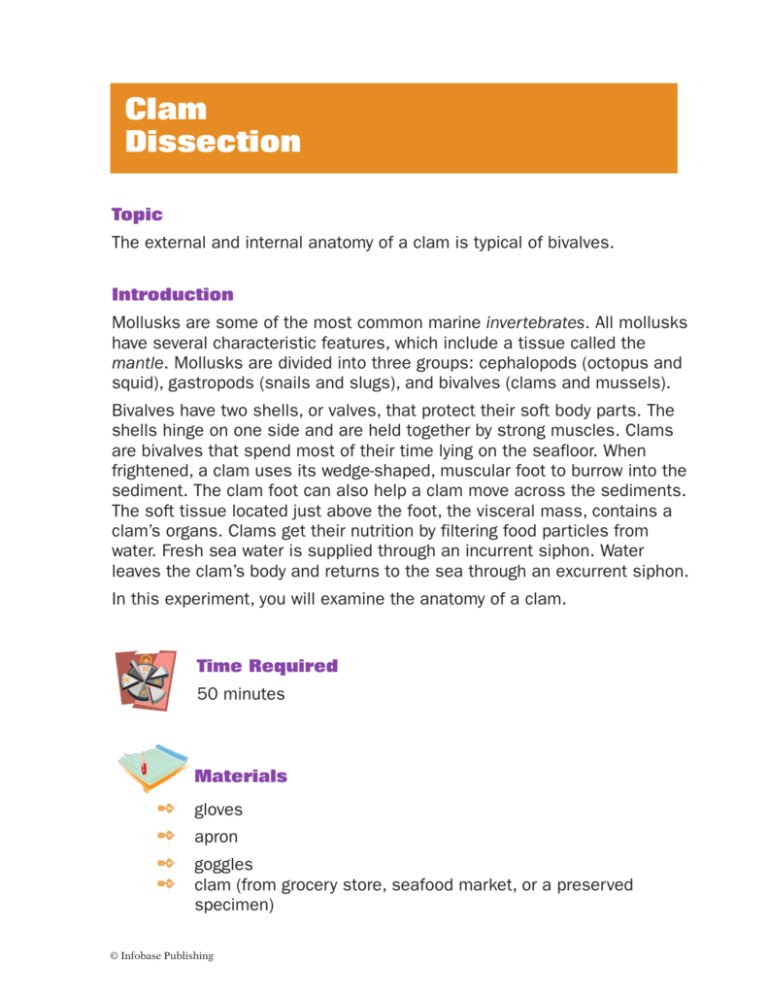
Clam Dissection Topic The external and internal anatomy of a clam is typical of bivalves. Introduction Mollusks are some of the most common marine invertebrates. All mollusks have several characteristic features, which include a tissue called the mantle. Mollusks are divided into three groups: cephalopods (octopus and squid), gastropods (snails and slugs), and bivalves (clams and mussels). Bivalves have two shells, or valves, that protect their soft body parts. The shells hinge on one side and are held together by strong muscles. Clams are bivalves that spend most of their time lying on the seafloor. When frightened, a clam uses its wedge-shaped, muscular foot to burrow into the sediment. The clam foot can also help a clam move across the sediments. The soft tissue located just above the foot, the visceral mass, contains a clam’s organs. Clams get their nutrition by filtering food particles from water. Fresh sea water is supplied through an incurrent siphon. Water leaves the clam’s body and returns to the sea through an excurrent siphon. In this experiment, you will examine the anatomy of a clam. Time Required 50 minutes Materials ✒ ✒ ✒ ✒ gloves apron goggles clam (from grocery store, seafood market, or a preserved specimen) © Infobase Publishing CLAM DISSECTION ✒ ✒ ✒ ✒ ✒ 2 dissecting pan screwdriver scalpel probe science notebook Safety Note Please review and follow the safety guidelines. Gloves should be worn when handling a preserved clam. Take care when working with the scalpel and when using the screwdriver to open the clam. Procedure 1. 2. 3. Put on your lab apron, safety goggles, and gloves. Place the clam in the dissecting tray. Examine the exterior surfaces of the clam’s valves. Refer to Figure 1 to locate the umbo and the anterior and posterior ends of the clam. Note that the curve in the umbo points toward the clam’s anterior end. dorsal (top surface) hinge ligament umbo anterior posterior left valve ventral (bottom surface) Figure 1 © Infobase Publishing CLAM DISSECTION 4. 5. 6. 7. 8. 3 A series of growth lines extend from the umbo. Count the growth lines on the clam’s shell to determine its age, and record the age in your science notebook. Locate the position of the hinge ligament, which is used to hinge the valves together. Identify the ventral and dorsal surfaces. Place the clam so that its dorsal side is flat on the dissecting tray. Carefully work the tip of the screwdriver between the clam’s valves. Turn the screwdriver so that the clam shell is slightly ajar. Study Figure 2 to help locate the large adductor muscles that hold the valves together. Use your scalpel to cut these two muscles. Make the cuts as close to one of the valves as possible, taking care not to damage nearby tissue. Figure 2 Open the clam, bending the top valve back so that it rests in the dissecting tray. Examine the interior of both valves. One valve holds the soft body of the clam. In the other valve, locate the thin lining, which is part of the mantle. Mantle tissue lines both valves and covers the body of the clam. 10. Using Figure 3 as a guide, locate two tube-like openings on the posterior end. The more ventral opening is the incurrent siphon that supplies water to the gills. The other is the excurrent siphon that returns water to the sea. 9. © Infobase Publishing CLAM DISSECTION 4 gills palps posterior adductor muscle mouth siphons anterior adductor muscle mantle foot Figure 3 11. Remove the thin layer of mantle tissue that covers the soft body of the clam. Beneath the mantle are the gills and the muscular foot. 12. With scissors, cut out the lower portion of the foot. Use the scalpel to cut the remaining portion of foot in half. Peel the two halves back to reveal the clam’s internal organs beneath. 13. Beneath the mantle locate the spongy, yellow reproductive organ. 14. Find the two flap-like palps, structures that surround the mouth and help funnel food into it. Separate the palps to find the mouth. 15. Locate the stomach, which is surrounded by a greenish digestive gland. 16. Find the long, coiled intestine, which travels from the stomach to the anus. This is located near the posterior adductor muscle. 17. Examine the heart, which is enclosed in a clear sac called the pericardium. Notice how the intestine runs through the pericardium. Analysis 1. Why are clams called bivalves? 2. What is the oldest part of the clam shell? 3. How do clams open and close their shells? 4. How does a clam draw water into its mantle cavity? What is the purpose of this behavior? 5. Describe the shape of a clam’s foot and explain how the clam uses it for movement. © Infobase Publishing CLAM DISSECTION 5 6. What is meant by the term “filter feeding”? How do clams filter feed? 7. Describe the path of a food particle through a clam’s body, beginning at the point where it is drawn in the incurrent siphon and ending at the anus. What’s Going On? Clams are soft-bodied animals whose internal organs are protected by two shells. Like all mollusks, clams have a mantle. Located inside the mantle cavity are the digestive, respiratory, circulatory, reproductive, and nervous systems. Organs in all of these systems are visible, except for those of the nervous system. As filter feeders, clams collect tiny particles of food suspended in the water. Water is continuously drawn in through an incurrent siphon and circulated over the gills. Food particles stick to mucus that coats this respiratory organ. Cilia, tiny hair-like structures, sweep the food particles towards the clam’s mouth. Food is digested in the stomach and intestine. Wastes of digestion are excreted through the anus, and filtered water is returned to the sea by the excurrent siphon. Want to Know More? See Our Findings. © Infobase Publishing OUR FINDINGS CLAM DISSECTION Notes to teacher: If you use preserved specimens, order extra large clams from a biological supply house. Commercially graded #1 or #2 clams are pegged so students do not have to use screwdrivers to open them. Fresh clams can be purchased at the local grocery store or fish market. If living clams are available, keep them in water until time for dissection. When dissecting a living clam, the heart will still be beating, making that organ easy to identify. Analysis 1. Clams have two shells or valves. 2. The oldest part of the shell is the umbo. 3. Clams use the adductor muscles to open and close their shells. 4. Clams draw water into the mantle cavity through the incurrent siphon. Water brings in oxygen and food. 5. The foot is broad and shaped like a hatchet. The function of the foot is to help the clam move or dig into the soft seafloor. 6. Filter feeders are animals that filter tiny bits of food from the water. Clams filter feed with their gills. As water flows over the gills, mucus snares tiny pieces of food. Cilia on the gills move food toward the mouth. 7. The path of food through the clam is: incurrent siphon, gills, mouth, stomach, intestines, anus. © Infobase Publishing SAFETY PRECAUTIONS Review Before Starting Any Experiment Each experiment includes special safety precautions that are relevant to that particular project. These do not include all the basic safety precautions that are necessary whenever you are working on a scientific experiment. For this reason, it is necessary that you read and remain mindful of the General Safety Precautions that follow. Experimental science can be dangerous, and good laboratory procedure always includes carefully following basic safety rules. Things can happen very quickly while you are performing an experiment. Materials can spill, break, or even catch fire. There will be no time after the fact to protect yourself. Always prepare for unexpected dangers by following the basic safety guidelines during the entire experiment, whether or not something seems dangerous to you at a given moment. We have been quite sparing in prescribing safety precautions for the individual experiments. For one reason, we want you to take very seriously every safety precaution that is printed in this book. If you see it written here, you can be sure that it is here because it is absolutely critical. Read the safety precautions here and at the beginning of each experiment before performing each activity. It is difficult to remember a long set of general rules. By rereading these general precautions every time you set up an experiment, you will be reminding yourself that lab safety is critically important. In addition, use your good judgment and pay close attention when performing potentially dangerous procedures. Just because the text does not say “be careful with hot liquids” or “don’t cut yourself with a knife” does not mean that you can be careless when boiling water or punching holes in plastic bottles. Notes in the text are special precautions to which you must pay special attention. GENERAL SAFETY PRECAUTIONS Accidents caused by carelessness, haste, insufficient knowledge, or taking an unnecessary risk can be avoided by practicing safety procedures and being alert while conducting experiments. Be sure to check the individual experiments in this book for additional safety regulations and adult supervision requirements. If you will be working in a lab, do not work alone. When you are working off site, keep in © Infobase Publishing SAFETY PRECAUTIONS 2 groups with a minimum of three students per group, and follow school rules and state legal requirements for the number of supervisors required. Ask an adult supervisor with basic training in first aid to carry a small first-aid kit. Make sure everyone knows where this person will be during the experiment. PREPARING • Clear all surfaces before beginning experiments. • Read the instructions before you start. • Know the hazards of the experiments and anticipate dangers. PROTECTING YOURSELF • Follow the directions step-by-step. • Do only one experiment at a time. exits, fire blanket and extinguisher, master gas and • Locate electricity shut-offs, eyewash, and first-aid kit. • Make sure there is adequate ventilation. • Do not horseplay. • Keep floor and workspace neat, clean, and dry. • Clean up spills immediately. • If glassware breaks, do not clean it up; ask for teacher assistance. • Tie back long hair. • Never eat, drink, or smoke in the laboratory or workspace. not eat or drink any substances tested unless expressly • Do permitted to do so by a knowledgeable adult. USING EQUIPMENT WITH CARE • Set up apparatus far from the edge of the desk. • Use knives or other sharp-pointed instruments with care. • Pull plugs, not cords, when removing electrical plugs. • Clean glassware before and after use. • Check glassware for scratches, cracks, and sharp edges. © Infobase Publishing SAFETY PRECAUTIONS 3 • Clean up broken glassware immediately. • Do not use reflected sunlight to illuminate your microscope. • Do not touch metal conductors. • Use alcohol-filled thermometers, not mercury-filled thermometers. USING CHEMICALS • Never taste or inhale chemicals • Label all bottles and apparatus containing chemicals • Read labels carefully. chemical contact with skin and eyes (wear safety glasses, lab • Avoid apron, and gloves). • Do not touch chemical solutions. • Wash hands before and after using solutions. • Wipe up spills thoroughly. HEATING SUBSTANCES • Wear safety glasses, apron, and gloves when boiling water. • Keep your face away from test tubes and beakers. test tubes, beakers, and other glassware made of Pyrex™ • Use glass. • Never leave apparatus unattended. • Use safety tongs and heat-resistant gloves. your laboratory does not have heat-proof workbenches, put your • IfBunsen burner on a heat-proof mat before lighting it. care when lighting your Bunsen burner; light it with the airhole • Take closed, and use a Bunsen burner lighter in preference to wooden matches. • Turn off hot plates, Bunsen burners, and gas when you are done. flammable substances away from flames and other sources • Keep of heat. • Have a fire extinguisher on hand. © Infobase Publishing SAFETY PRECAUTIONS 4 FINISHING UP • Thoroughly clean your work area and any glassware used. • Wash your hands. careful not to return chemicals or contaminated reagents to the • Be wrong containers. • Do not dispose of materials in the sink unless instructed to do so. up all residues and put them in proper containers for • Clean disposal. of all chemicals according to all local, state, and federal • Dispose laws. BE SAFETY CONSCIOUS AT ALL TIMES! © Infobase Publishing




